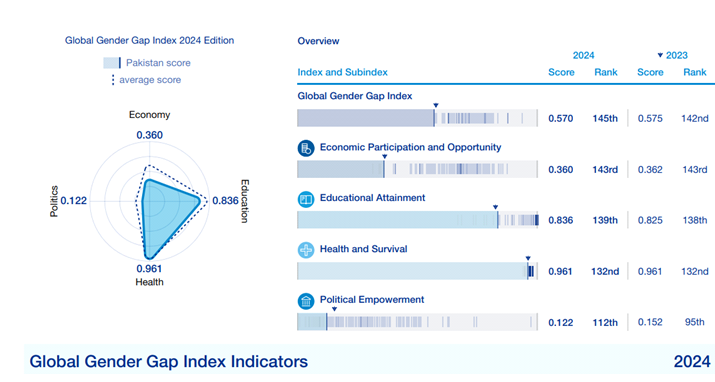i INP-WEALTHPK
Kanwal Naseer

Women constitute almost half of Pakistan’s population but despite this impressive numeric strength, they make a very small part of the workforce and their participation rate is notably low due to insufficient focus on their empowerment. Traditional norms often prioritize male employment, leaving women with limited options, reports WealthPK.

According to the World Economic Forum's Global Gender Gap Report 2024, Pakistan has been ranked 145 out of 146 countries. This represents a decline from its 142nd position in 2023, highlighting growing challenges in achieving gender parity. Pakistan's female workforce participation rates are notably lower than the global averages. In the textile and garment sector, women represent approximately 30% of the workforce, which is significantly lesser than in other countries with major garment manufacturing industries. Bangladesh has a participation rate of 65%, Sri Lanka 76%, China 66%, Cambodia 82%, Vietnam 79%, and Indonesia 65%. Talking to WealthPK, founder of Islamabad Chamber of Commerce and Industry Samina Fazil said, “Women in neighbouring countries like India and Bangladesh are playing an instrumental role in economic development. Unfortunately, in Pakistan, despite making up 50 percent of the population, their participation in the workforce is significantly low.” “As a women's chamber, our objective is to integrate skilled and empowered women into the national workforce, enabling them to play an active role in driving Pakistan's economic development.
By providing comprehensive training, we seek to equip these women with the necessary skills and confidence to thrive in various professional sectors.” “When more women enter the workforce, economies experience growth. Higher female labour participation contributes to economic diversification and promotes income equality, leading to shared prosperity and development for all,” she said. According to ILO, since 2000 Pakistan’s labour productivity has grown at a rate of 1.5% annually. In comparison, India’s labour productivity has grown by 5.7% and China’s by 8.8% during the same period. Pakistan’s GDP output per worker in 2021 was $3,801, lower than India’s $6,688 and Vietnam’s $3,905. WealthPK reports. Talking to WealthPK, Presidnet of Women Chamber of Commerce and Industry, Quetta Mehwish Kanwal said to foster greater female participation in the workforce, it was essential to implement thoughtful strategies that create an equitable environment. She said, “Key actions include enhancing financial accessibility, offering flexible work schedules, and improving childcare services. Furthermore, it is crucial to recognize and support the contribution of women in our rural areas."
Credit: INP-WealthPk



